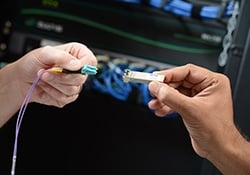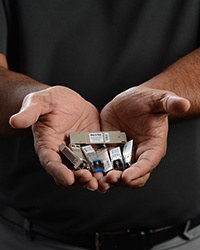TRANSMITTER + RECEIVER = TRANSCEIVER
 The transceiver, cabling, and connectivity together make up the link between two pieces of active networking devices. Traditionally, these little pluggable devices have been thought of in relation to the active equipment they’re plugged into. But since a transceiver’s performance has more to do with the cabling than the equipment, doesn’t it make more sense for the cables and transceivers to be specified together?
The transceiver, cabling, and connectivity together make up the link between two pieces of active networking devices. Traditionally, these little pluggable devices have been thought of in relation to the active equipment they’re plugged into. But since a transceiver’s performance has more to do with the cabling than the equipment, doesn’t it make more sense for the cables and transceivers to be specified together?
Back in the day, cabling was considered part of the equipment. If you specified an IBM computer system, for example, the associated cable was part of the solution.
But with the growth of structured cabling, the cabling became independent of the active equipment, and those who purchased each component (typically, the Facilities Manager for cabling and the Network Manager for transceivers), started to operate separately from each other. A “You worry about yours, and I’ll worry about mine” mentality was adopted, and it’s worked pretty well for the last 30+ years.
If it's not broken, why fix it?
 The problem is this: With ever-growing data rates, there are now some infrastructures that twisted pair cabling can’t cost effectively support. This is especially evident in the data center, where data rates are higher and the pace of change is exponentially faster than in the enterprise LAN. Furthermore, endless combinations of data rates, operating wavelengths and fiber types result it an almost infinite number of reach possibilities.
The problem is this: With ever-growing data rates, there are now some infrastructures that twisted pair cabling can’t cost effectively support. This is especially evident in the data center, where data rates are higher and the pace of change is exponentially faster than in the enterprise LAN. Furthermore, endless combinations of data rates, operating wavelengths and fiber types result it an almost infinite number of reach possibilities.This has created a conflict in the specification process – the IT equipment decisions are no longer independent of the structured cabling decisions, and the impact is felt through the supply channel, since the products are sourced in different ways. Not to mention trying to figure out whom to call for technical support if a link fails. Is the equipment’s fault or the cable’s?
So how can you manage this complexity? By redefining the link and who’s responsible for it.
Shifting transceiver responsibility from the Network Manager to the Facilities Manager will allow your organization to make its decisions much more efficiently. The Network Manager doesn’t need to worry about the myriad fiber and transceiver options, nor the impacts they have on each other. And the Facilities Manager – whose experience with fiber and connectivity options puts him/her in a better position to determine which transceiver is the most appropriate – can manage the entire optical link, from transceiver to transceiver.
Download the FAQ on Compatibility and OEM Guidelines for additional information and resources:
For more information about Berk-Tek's transceivers, or for any other questions, please contact your local Accu-Tech representative.
This post originally appeared on Berk-Tek's TekTalk blog.





.png?width=58&height=58&name=X_logo_2023_(white).png)
